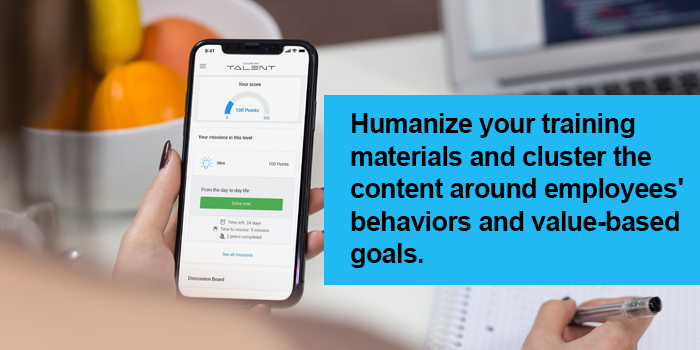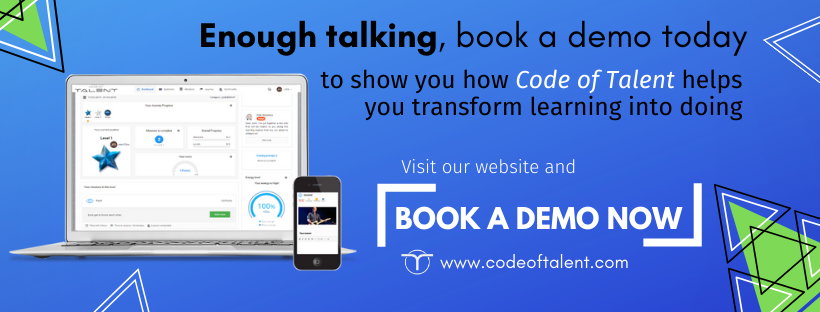The COVID19 pandemic emerged as a global health crisis and brought the world economy to a halt, and wreak havoc on the business world. Companies were left counting costs and trying to adapt to the changing dynamics of the corporate stratosphere. The first budget cuts were those for L&D, as face-to-face training, both internal and external, were immediately shut down, and work from home became the new normal.
The working life has changed manifolds during this year. With our homes becoming the new business parks, L&D professionals and leadership management had to face unprecedented times full of obstacles in the way of engaging and motivating the workforce remotely. Several months have passed since the coronavirus outbreak, but we wonder what recovery could look like.
Topics we will cover:
Bringing Employees Together While Working From Home
The coronavirus crisis raised many health and safety concerns for businesses, causing them to shift their focus to workplace safety training and eventually to remote work training upon the imposition of nationwide lockdown.
This resulted in added pressure on the L&D departments, especially in the manufacturing, automotive, and retail industries. They need to reach thousands of employees in thousands of different locations and engage them with the company's modified processes and programs. They are now responsible for empowering the workforce to cope with the new demands.
So, where do they start?
With workplace trends related to digital working on the rise, companies have started seeing e-learning as a potential lifesaver. Microlearning, in particular, has brought a ray of hope for L&D and HR professionals have been struggling to find ways and tools to reach and engage employees.
The Biggest Concerns for L&D during the Pandemic
While things went haywire for businesses, most companies managed to find different ways to communicate and reach their employees at their homes. A similar approach was taken to conduct corporate training. However, despite all the efforts put in, they are still struggling to keep the employees engaged and motivated.
Sales teams faced some of the biggest challenges. Other concerns businesses have had include product knowledge transfer, reskilling and upskilling, the rapid transformation of the acquired knowledge into actions without time and productivity loss, and going 100% digital on the onboarding process.
The following questions seem to have been keeping L&D awake at night during the pandemic:
- How can we improve the communication skills of our employees?
- How can we continue to build and foster a collaborative culture while working remotely?
- How can we build the new skill set for leadership in accordance with the new normal?
- How should we handle the digital nomad environment while keeping the employees engaged?
Incorporating Microlearning in Your Learning and Development Strategy is the Way to Go
One way to boost employee engagement during the ongoing crisis is by offering unparalleled learning and development opportunities to your workers. Companies that focus on learning and development are likely to enjoy higher employee engagement and faster organizational growth.
Organizations struggle with keeping their workers engaged because the learning process itself is not engaging. This is especially true with the current remote working situation. No matter how much time, energy, and money you invest in conducting training sessions, the employees won't learn a thing if they don't get engaged.
Modern-day employees need to know that their employers are concerned about and interested in their career development, especially during these uncertain times. They want the satisfaction that you're willing to take time to measure, discuss, and encourage their progress. Adopting a microlearning approach to learning and development can help you deliver effective training sessions, that too in a time and cost-efficient manner.
It goes without saying that investing in employee learning and development shows your workers that you value them and are willing to help them achieve their career goals.
How Learning and Development Drives Employee Engagement
We've established that learning and development opportunities are the top drivers of employee engagement for organizations across industries. Learning, on its own, is an excellent engagement tool. And if done right, it can significantly boost employee performance and productivity during the pandemic.
Furthermore, if a learning program becomes popular, it will quickly spread across networks. On top of that, it will ultimately create socially generated content if it manages to inspire people. All of this adds magnanimously to employee engagement.
4 Reasons Learning and Development Improves Employee Engagement
Here's how learning and development foster employee engagement.
1. Improves Employee Retention
When staying on top of your business processes and workflows has become overwhelming, you wouldn't want your best employees to leave. Losing workers who are well in tune with your business vision and values means you'll have to invest extra time, money, and efforts to acquire new employees and get them on board.
When employees receive adequate and quality learning opportunities at work, they feel valued and hence, are less likely to leave the organization. According to a LinkedIn report, 94% of employees would prefer staying at a company if it found ways to help them with career development.
 When employers invest their time and energy in helping the employees grow, people realize that they can achieve their personal goals while staying within the organization. They even begin to feel more committed to company goals and growth. As a result, their productivity and performance go up and up.
When employers invest their time and energy in helping the employees grow, people realize that they can achieve their personal goals while staying within the organization. They even begin to feel more committed to company goals and growth. As a result, their productivity and performance go up and up.
Here are a few ways you can improve employee retention with learning and development initiatives during the pandemic.
- Design training programs for various stages highlighting specific career paths
- Offer courses for skill development catering to different interests and learning styles of employees
- Focus more on critical digital and life skills
- Promotions upon mastering key competencies
2. Paves the Way for Organizational Change
We can't stress enough about the need for organizational change born due to the COVID-19 crisis. While people can't wait for things to go back to normal, we can't decide what normal even looks like yet.
Companies undertaking change management during these times are smart! Whether you're still working from home or have reopened your offices partially, it is critical to introduce new systems and strategies to sustain the pandemic and manage its impact.
Now, the fear of the unknown may make organizational change a little overwhelming for you, especially during these challenging times. However, you don't have to worry as long as your employees are equipped with the skills and resources required to navigate change. Learning and development plays an integral role here.
Thanks to microlearning, you don't have to have face-to-face meetings and physical training at the office anymore. Managers can work on and implement organizational changes while the employees work remotely. Using microlearning platforms, like Code of Talent, they can design effective digital learning journeys to ensure the employees are prepared for change and can approach it with confidence and optimism.
You can come out as a better and more efficient organization if you provide your employees with excellent microlearning experiences and encourage them to embrace shifts in work processes and strategies. Taking the microlearning approach is the best bet for you right now because it boosts employee engagement, knowledge retention, and productivity, which is all you need during these testing times.
3. Promotes Teamwork
Learning and development motivate employees to come together as a team and work collaboratively to achieve shared goals. People learn best when they collaborate and are given an opportunity to share knowledge.
When employers take such initiatives, team members learn ways to effectively communicate, resolve conflicts, share information, and support each other. All in all, they learn to be productive and better team workers who contribute to organizational growth.
Kingston Business School's 2018 interim report to CIPD implied that "engagement is about creating opportunities for employees to connect with their colleagues, managers, and the wider organization. It is also about creating an environment where employees are motivated to want to connect with their work and really care about doing a good job".
Another study observed that communication, leadership, and work-life balance were the top drivers of employee engagement. The kind of relationship employees have with their coworkers affects their engagement levels. You can't have all the employees working in the same office due to the COVID19 pandemic, but with the right learning and development approach, you can give them a chance to connect and strengthen as a team.
4. Improves Leadership
No organization can climb the ladder of success without great leaders. The learning and development initiatives you take during these times must ensure that all existing and future leaders at key positions possess the knowledge, skills, and resources required to inspire the workforce.
Below are a few examples of training opportunities that you can offer to enhance leadership competencies in your employees while they work from home.
- Soft skills training focused on critical thinking, decision-making, communication, and teamwork
- Leadership sessions teaching employees how to be a leader for self and others
- Rotational opportunities to introduce new processes and tasks to people
Tips to apply during this period to engage your employees
Here are a few helpful tips on how learning and development can improve your employee engagement levels and yield tremendous benefits for your organization during these challenging times.
Cultivate a Strong Learning Culture
First and foremost, determine the type of learning culture you want to promote among the remote workers. Needless to say, it should resonate with your business vision, values, and goals. It should also perfectly align with your employee engagement strategy.
Make sure you communicate the details related to your desired learning culture clear and loud, so your employees know what to expect. So, suppose you want to foster a culture of innovation. In that case, you'd have to devise a learning and development strategy that encourages employees to think out of the box, share ideas, and listen to others.
Give Your Employees Something to Engage with
For every learning and development program, as yourself, "What is it that you are asking your employees to engage with?"
To make the learning journey successful, you must provide people with something they can relate to and engage with. Your employees won't find the training sessions useful if they don't feel a part of it. Try to humanize your training materials and cluster the content around employees' behaviors and value-based goals. Most importantly, put your business values at the heart of all your learning and development efforts.

That being said, microlearning is a fantastic option if you want to take your learning and development programs up a notch during the COVID19 crisis. Managers and trainers can benefit from a multitude of learning missions available on microlearning platforms to create exceptional, highly engaging digital journeys for their employees. It's high time you invite your teams to dive into the world of stories, questions, quizzes, surveys, videos, images, and points of view on a microlearning platform!
Leverage the Power of Technology
It is crucial to use technology as an enabler for employee learning and development in the modern digital world. With specific cultural and behavioral goals to achieve, you can lay the foundation for a successful learning journey. Since modern-day employees tend to find the meaning behind everything, you should focus on making the learning program meaningful with technology to achieve long-term goals.
This is where Learning Experience Platforms (LXPs) come in. Designed to drive employee engagement from various sources, these platforms help learners find the right content at the right time and allow collaboration across the organization. This aligns perfectly with the needs, preferences, and expectations of remote workers.
Microlearning platforms, in particular, are all the rage in the modern digital learning world. These learner-centric platforms make learning fast-paced yet the concepts are made accessible and easy-to-grasp. Employees can learn whatever they want to on the device of their choice.
Moreover, microlearning fits best for mobile-based learning, as learners can access content anytime from anywhere as per their convenience. Besides, the nuggets of information are super easy to update and perfect for boosting learner motivation.
No wonder companies are exploiting their technology stack to design engaging microlearning journeys for their employees during the pandemic. You can jump on the bandwagon too and enjoy the many benefits of microlearning. To learn more, contact us NOW!
Important tip: Make sure you understand the needs and interests of your audience before jumping into the world of gamification, discussion forums, and badges. While it's great to use multiple channels, you must test the water before introducing new ones.
Gain Your Employees' Trust and Learn from Them
One reason for low employee engagement levels may be their training-is-just-a-waste-of-time mindset. To change this, you need to earn your employees' trust in learning and development. It would help if you conveyed that you're eager to adjust their work situations and train them, equipping them with the right tools and resources they need to cope with remote working challenges.
The best way to do so is by asking questions and listening to the people. While you may have research data to prove which type of content is popular for corporate training, nothing beats finding out what your employees need and when they need it. Thanks to modern technology, you can quickly respond to their feedback and offer them a customized learning experience.
According to the 2018 Global Talent Trends study, 51% of the employees were looking for more flexible work options, helping them maintain a positive work-life balance. Please note that flexibility can come in the corporate training form too. Modern-day learners want to learn whenever and wherever they want based on their schedules. Therefore, make sure you ask your employees what they like and how they want it.
Furthermore, you should consider providing your employees with opportunities to learn while doing. Learning doesn't have to feel like learning. You can make it engaging and exciting by using different content formats and microlearning tools and resources. You need to change your employees' mindset and prove that training sessions can be fun while being informative at the same time!
Train Leaders and Managers
Many employers don't realize that managers and leaders can make or break employee engagement, happiness, and retention. By providing behavioral and performance-based training opportunities, you can ensure that these leaders are well-equipped to cater to the needs of their teams and promote the desired culture at the workplace during the pandemic.
Think Social Learning
To engage remote employees, you must offer flexible training opportunities. The idea is to encourage people to be more involved, collaborative, and supportive when working with each other from home. This is where social learning platforms come in as a necessity. While everyone is working remotely, you should be flexible and offer informal learning where you can.
After setting up a learning forum, get everyone excited and reinforce interactions and discussions. Also, when coming up with learning resources, make sure the employees can like, share, and comment on the content easily. This will boost motivation, empower employees, and allow them to give feedback to their colleagues. After all, that's what social learning is all about!
Final Thoughts
Ready to boost employee engagement and performance with learning and development during the pandemic as well as in the post-COVID19 world?
Stop waiting for things to get back to normal and start capitalizing on the opportunities that lay ahead of you!
Let's lay a strong foundation for a culture of ongoing learning, trust, and empowerment and be in tune with the remote workers' changing needs. Encourage your learning and development teams to work with HR to improve the learning experience they offer and use digital technologies to bring a positive cultural change during the pandemic.
Building employee engagement with exceptional learning and development opportunities may seem challenging during these unprecedented times, but it is not impossible. You can start today.
It’s time to turn learning into doing with Code of Talent.


.jpg)

